
Catocala retecta, the yellow-gray underwing, is a moth of the family Erebidae. The species was first described by Augustus Radcliffe Grote in 1872. It can be found in North America from southern Ontario and Quebec south through Maine and New Jersey, south through Tennessee to Georgia and west to Arkansas and Kansas and north to Wisconsin. There is one recognised subspecies, Catocala retecta luctuosa, which is sometimes treated as a valid species with the common name yellow-fringed underwing.
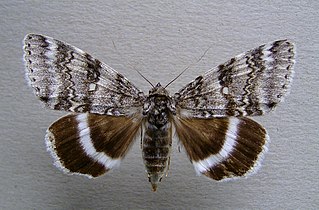
Catocala relicta, the white underwing or relict, is a moth of the family Erebidae. The species was first described by Francis Walker in 1858. It lives in southern Canada, from Newfoundland to Vancouver Island, south to Missouri, and Arizona.
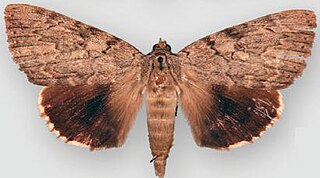
Catocala agrippina, the Agrippina underwing, is a moth of the family Erebidae. The species was first described by Herman Strecker in 1874. It is found in the United States from southern New Jersey south to Florida, west to Texas and eastern Oklahoma and north to southern Indiana.

Catocala angusi, commonly known as Angus' underwing, is a species of moth in the family Erebidae. It is found from Massachusetts and Connecticut south to Georgia west to Arkansas and Kansas and north to Illinois and Michigan.
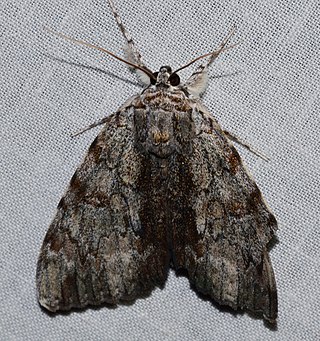
Catocala insolabilis, the inconsolable underwing, is a moth of the family Erebidae. The species was first described by Achille Guenée in 1852. It is found in North America from Ontario through Maine and Connecticut south to Florida, west through Arkansas to Texas and Oklahoma and north to South Dakota.

Catocala judith, or Judith's underwing, is a moth of the family Erebidae. The species was first described by Strecker in 1874. It is found in North America from southern Quebec and Ontario to the United States from New Hampshire south through Connecticut and New Jersey to North Carolina and Georgia, west to Oklahoma and Iowa and north to Wisconsin.
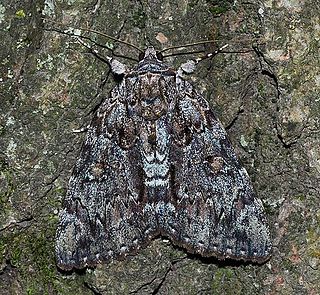
Catocala lacrymosa, the tearful underwing, is a moth of the family Erebidae. It is found from Massachusetts and Connecticut south to Florida, west to Texas and eastern Oklahoma and north to Illinois and Michigan and into southern Ontario.

Catocala obscura, the obscure underwing, is a moth of the family Erebidae. The species was first described by Ferdinand Heinrich Hermann Strecker in 1873. In Canada it is found in southern Quebec and Ontario and in the United States it is found from Massachusetts and Connecticut south to North Carolina, west to Mississippi and north to Iowa, Illinois, Ohio, and Michigan.
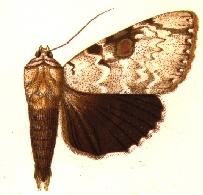
Catocala sappho, the Sappho underwing, is a moth of the family Erebidae. The species was first described by Ferdinand Heinrich Hermann Strecker in 1874. It is found from Virginia and Tennessee south to Florida and west to Louisiana, Mississippi, Texas, Missouri and Illinois.
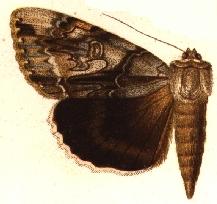
Catocala vidua, the widow underwing, is a moth of the family Erebidae. The species was first described by James Edward Smith in 1797. It is found in North America from southern Ontario, into Maine, New Hampshire and Connecticut, south at least to Tennessee, Georgia and Alabama, west to Texas and Oklahoma, and north to Wisconsin.

Catocala consors, the consort underwing, is a moth of the family Erebidae. It is found from Maine and Connecticut south to Florida and west to Texas and eastern Oklahoma.

Catocala flebilis, the mourning underwing, is a moth of the family Erebidae. The species was first described by Augustus Radcliffe Grote in 1872. It is found in North America from Massachusetts and Connecticut south to North Carolina and Georgia, west to Arkansas and north to Michigan and Illinois and into southern Ontario.

Catocala maestosa, commonly known as the sad underwing, is a species of moth in the family Erebidae. The species was first described by George Duryea Hulst in 1884. It is found in the United States from New York south to Florida and Alabama, west to Texas and eastern Oklahoma and north to Illinois, Indiana and Minnesota.

Catocala palaeogama, the old wife underwing, is a moth of the family Erebidae. The species was first described by Achille Guenée in 1852. It is found in North America from Ontario and Quebec, through Maine, New Jersey, Tennessee, to South Carolina, west to Arkansas and Oklahoma and north through Iowa, Indiana, Illinois and Michigan.
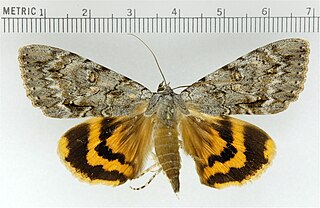
Catocala habilis, the habilis underwing, is a moth of the family Erebidae. The species was first described by Augustus Radcliffe Grote in 1872. It is found in North America from Quebec, Ontario, Manitoba, and New Brunswick south through Connecticut and New Jersey to North Carolina and west to Arkansas.

Catocala nebulosa, the clouded underwing, is a moth of the family Erebidae. The species was first described by William Henry Edwards in 1864. It is found in North America from southern Ontario south through Tennessee to Florida, west to Texas and eastern Oklahoma and north to Iowa, Michigan, Wisconsin and Minnesota.

Catocala subnata, the youthful underwing, is a moth of the family Erebidae. The species was first described by Augustus Radcliffe Grote in 1864. It is found in North America from Manitoba, Ontario, Quebec, and New Brunswick to Nova Scotia, south through Maine and Connecticut to North Carolina and west to Tennessee, Kentucky, and Texas, then north to Iowa, Wisconsin, and Michigan.
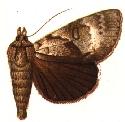
Catocala andromedae, the Andromeda underwing or gloomy underwing, is a moth of the family Erebidae. The species was first described by Achille Guenée in 1852. It is found in the United States from Maine south through New Jersey to Florida and Alabama and west to Texas and Oklahoma.

Catocala similis, the similar underwing, is a moth of the family Erebidae. The species was first described by William Henry Edwards in 1864. It is found in North America from Ontario and Quebec south through Maine and Connecticut to Florida, west to Texas and Oklahoma, and north to Minnesota.
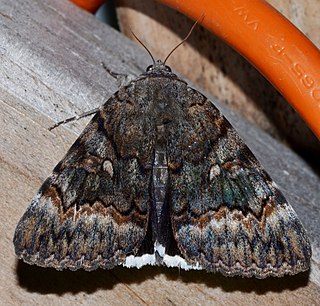
Catocala epione, the Epione underwing, is a moth of the family Erebidae. The species was first described by Dru Drury in 1773. It is found in North America from Quebec and Ontario south through Connecticut to Florida and west to Texas and Oklahoma.













